An Overview of Behavioral Interventions in Autism Therapy
Applied Behavior Analysis (ABA) therapy is a well-established, science-based approach that focuses on modifying behavior to improve the lives of individuals with autism and other developmental conditions. Among the various clinical strategies employed within ABA, response blocking emerges as a targeted physical intervention used to prevent maladaptive behaviors. This article delves into what response blocking is, how it fits within ABA practices, and its practical applications and considerations.
Fundamentals of Applied Behavior Analysis Therapy
What is Applied Behavior Analysis (ABA) therapy?
Applied Behavior Analysis (ABA) therapy is an evidence-based approach focused on understanding and shaping human behavior by analyzing environmental influences and implementing targeted interventions. The main goal of ABA is to enhance beneficial skills such as communication, socialization, and academics while reducing problematic behaviors. Techniques commonly used include positive reinforcement, prompting, and breaking down tasks into smaller steps.
Goals and methods of ABA
ABA targets individualized behavior change by applying scientific principles to increase desirable actions and decrease maladaptive ones. Programs are data-driven, utilizing ongoing measurement and evaluation to guide decision-making. Interventions might involve teaching new skills or using strategies like response blocking to prevent harmful behaviors. The therapy prioritizes generalizing learned behaviors to everyday environments, ensuring the individual can apply skills practically.
Role of professionals in ABA therapy
ABA therapy is typically designed and supervised by qualified professionals such as Board Certified Behavior Analysts (BCBAs). These experts conduct assessments, develop intervention plans, and train caregivers or educators involved in the individual’s program. Their expertise ensures approaches are grounded in research and tailored to each person’s unique needs, maximizing effectiveness and promoting meaningful progress.
Together, these components form a comprehensive framework for ABA therapy, widely applied to support individuals with developmental or behavioral challenges, especially those with autism spectrum disorder, aiming to improve independence and life quality.
How ABA Therapy Supports Individuals with Autism
How does ABA therapy help individuals with autism?
Applied Behavior Analysis (ABA) therapy applies scientific principles of learning and behavior to improve communication, social skills, and daily living in individuals with autism. It uses individualized, evidence-based programs that focus on enhancing positive behaviors and reducing problematic ones. ABA employs techniques such as positive reinforcement, prompting, and careful analysis of antecedents and consequences (the ABC model) to shape behavior over time.
Application of ABA in autism
ABA therapy starts with a detailed assessment of behaviors to identify specific goals. Through consistent data collection and monitoring, therapists can adapt sessions to each person's progress. Interventions often address various skills from language acquisition to self-care. Techniques like differential reinforcement and response blocking target maladaptive behaviors, such as repetitive actions or escape behaviors, by reinforcing alternative positive behaviors and preventing undesired responses.
Techniques used to encourage positive behaviors
Techniques commonly used include positive reinforcement for desired actions, prompting to guide correct responses, and response blocking to prevent harmful or undesired behaviors. For example, response blocking can physically prevent repetitive or self-injurious behaviors, helping individuals learn more appropriate responses. Visual supports are also incorporated to clarify expectations and reduce confusion.
Impact on independence and quality of life
By increasing functional skills and reducing challenging behaviors, ABA therapy promotes greater independence in daily activities and social interactions. This tailored approach fosters meaningful development, allowing individuals to participate more fully in home, school, and community settings. Parents and caregivers often report high satisfaction with ABA's practical effectiveness in improving their child's abilities and enhancing overall quality of life.
Qualifications and Roles of ABA Therapy Providers
Who provides ABA therapy and what qualifications do they have?
ABA therapy is delivered by professionals with specialized training in applied behavior analysis. The main providers include Board Certified Behavior Analysts (BCBAs) and Registered Behavior Technicians (RBTs).
To become an ABA therapist, individuals generally begin with a bachelor’s degree in psychology, education, or a related field. Many continue on to earn a master's degree focusing on applied behavior analysis or a related discipline. For advanced practice, BCBA certification is essential. Obtaining this certification involves completing approved coursework, obtaining supervised practical experience under a BCBA’s mentorship, and successfully passing a rigorous certification exam.
Educational requirements for ABA therapists
ABA therapists are expected to have a firm grounding in behavioral science. BCBAs must complete graduate-level training that covers research methods, behavior assessment, intervention techniques, and ethics. RBTs require less extensive training but must demonstrate competency through standardized training programs and ongoing supervision.
Certification and ethical standards
Certified professionals adhere to stringent ethical guidelines set by the Behavior Analyst Certification Board (BACB). These standards ensure that ABA therapy is delivered responsibly, respecting the dignity and needs of each client. Therapists also engage in continuing education to stay current with advances in the field, maintaining high-quality care.
Role of BCBAs and RBTs
BCBAs are responsible for designing, implementing, and supervising individualized behavior intervention plans. They conduct assessments such as functional behavior assessments, interpret data, and modify treatments as necessary. RBTs typically assist with direct therapy sessions, implementing strategies under BCBA supervision. Together, these qualified professionals work collaboratively to optimize behavioral and developmental outcomes for clients through evidence-based interventions.
Common Techniques in ABA Therapy: An Overview
What are some common techniques used in ABA therapy?
Applied Behavior Analysis (ABA) therapy employs various evidence-based techniques to help individuals develop new skills and reduce challenging behaviors.
One widely used method is Discrete Trial Training (DTT), which involves breaking down skills into small, manageable steps. Each trial consists of a clear instruction, a prompt if needed, a response from the learner, and a consequence like reinforcement.
Natural Environment Teaching (NET) shifts the focus to teaching skills within real-life contexts, encouraging generalization. Skills are taught by capitalizing on the learner's interests and naturally occurring opportunities.
Reinforcement strategies are central to ABA. Positive reinforcement rewards desired behaviors to increase their occurrence, while negative reinforcement involves removing unpleasant stimuli when the correct behavior occurs.
In addition, prompting and fading techniques are utilized to help learners achieve independence. Prompting involves guiding or assisting the learner to respond correctly, while fading gradually reduces that assistance over time.
Behavior chains break down complex tasks into sequences, teaching each step in order, which can be used in areas such as self-care and communication training.
Communication skills are often supported through strategies like Functional Communication Training (FCT) and augmentative methods to help individuals express their needs effectively.
Collectively, these approaches combine structured teaching, naturalistic settings, and systematic reinforcement to tailor interventions that support meaningful and lasting behavioral changes.
Effectiveness and Considerations in ABA for Autism
Is ABA therapy effective for all individuals with autism?
Applied Behavior Analysis (ABA) therapy is one of the most well-supported, evidence-based treatments for individuals with autism. It has shown significant improvements in social skills, communication abilities, and adaptive functioning. This widespread support comes from numerous studies highlighting the positive impacts of ABA when conducted properly.
Variability in outcomes and factors influencing effectiveness
Despite the strong evidence base, ABA is not equally effective for everyone. Outcomes depend heavily on individual factors such as the child’s unique needs, interests, and developmental profile. The intensity and quality of the intervention matter greatly, with typical recommendations being around 10 to 20 hours per week. Early intervention and involvement of qualified professionals such as Board Certified Behavior Analysts (BCBAs) and Registered Behavior Technicians (RBTs) significantly improve chances of success.
Importance of tailored and respectful approaches
While ABA focuses on behavior modification, contemporary practices emphasize designing programs that respect neurodiversity. This approach prioritizes building upon each individual's strengths and supporting meaningful participation in daily life rather than simply trying to normalize behavior. Tailored interventions that consider the preferences and dignity of the person are essential to ethical and effective ABA therapy.
Overall, ABA can be highly effective, but it is not a one-size-fits-all treatment. Personalization, quality of delivery, and respect for the individual’s unique experience are crucial components for achieving the best outcomes in autism therapy.
Defining Response Blocking in ABA Therapy

What response blocking entails
Response blocking is a behavioral intervention used in Applied Behavior Analysis (ABA) that involves physically preventing a maladaptive behavior from occurring. This technique works by removing access to the reinforcer, often escape or automatic sensory input, making the undesired behavior ineffective. For example, when a child begins to engage in thumb-sucking, a trained caregiver might use physical means, such as thumb guards, to block the behavior.
Its use as a physical intervention
As a physical intervention, response blocking typically requires someone, such as a teacher or caregiver, to closely observe the individual and intervene immediately as the maladaptive behavior begins. This intervention is especially practical with younger students, where blocking or physically guiding attempts to escape a task is feasible. However, with older or more aggressive individuals, alternative strategies might be necessary due to safety and practicality concerns.
Goals of the technique
The primary goal of response blocking is to prevent the occurrence of the maladaptive response while simultaneously providing feedback to the individual. This feedback helps the individual learn alternative, more appropriate behaviors. The procedure is typically integrated within broader educational or therapeutic programs and is especially effective for motor-based behaviors such as self-injury, aggression, or repetitive actions like thumb-sucking. Ultimately, response blocking aims to reduce harmful or disruptive behaviors, promoting better engagement and learning outcomes for the individual.
How Response Blocking Interrupts Maladaptive Behaviors
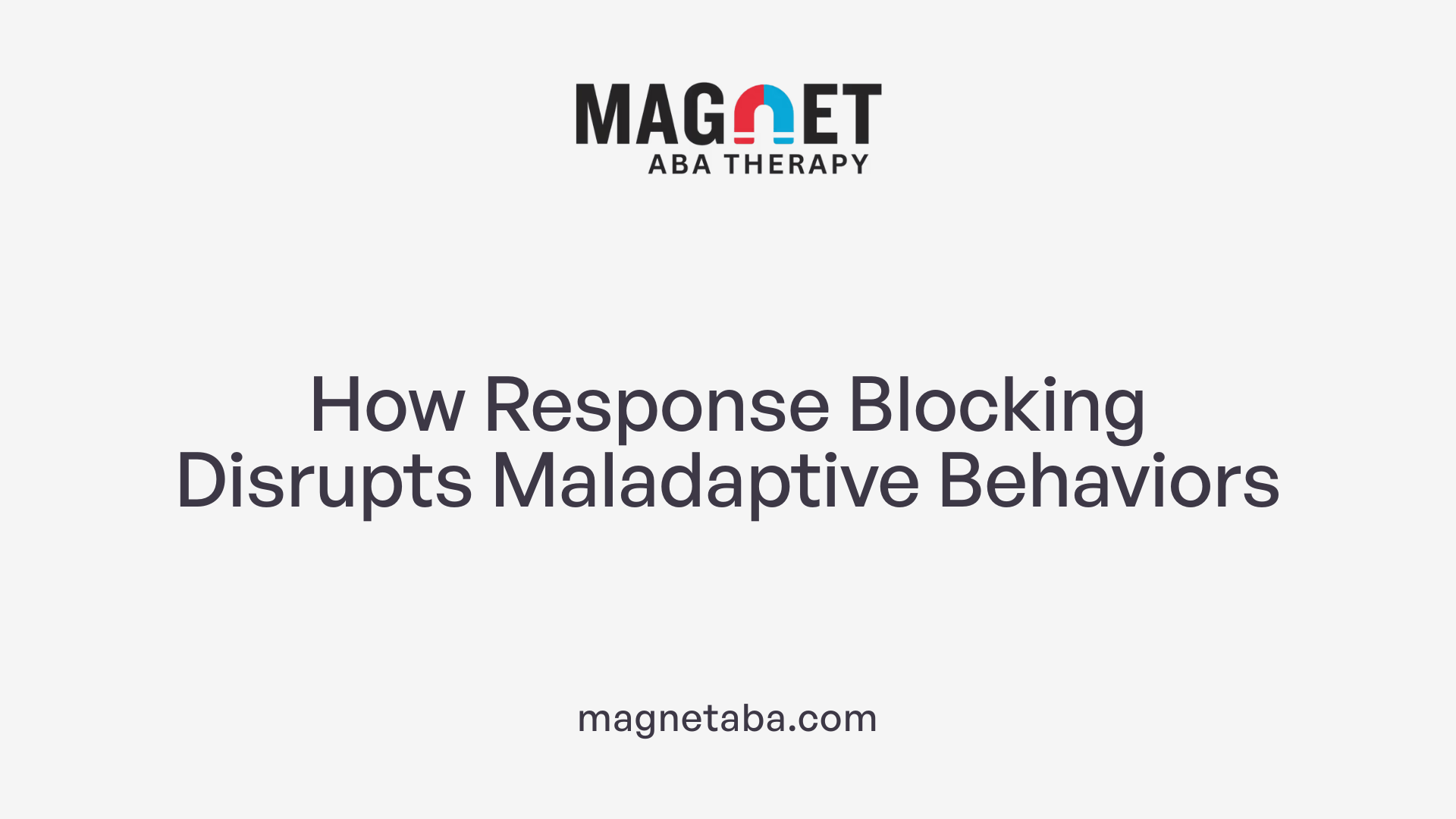
Removing Access to Reinforcers
Response blocking works by removing an individual's access to the reinforcer that maintains the maladaptive behavior, commonly escape from tasks or unwanted situations. For example, if a child attempts to avoid work by escaping, the intervention ensures escape is not possible, making the escape behavior ineffective. This approach helps the individual learn that these behaviors will not result in getting away from demands, reducing their occurrence over time.
Preventing Escape Behaviors
The method is especially practical with younger students where physical guidance or gentle blocking can prevent the child from escaping work tasks. For older or more aggressive individuals, however, response blocking may be less feasible, and alternative strategies should be considered.
Avoiding giving timeouts or breaks immediately after escape behaviors is critical, as such responses can inadvertently reinforce the undesired escape attempts. Instead, clear visual supports can help students understand that escape behaviors will not lead to a break, reinforcing more appropriate responses.
Physical Prevention of Targeted Behaviors
Response blocking involves physically preventing the exact motor actions associated with maladaptive behaviors, such as self-injury, aggression, or repetitive actions like thumb-sucking. The intervention is highly structured, beginning with clearly defining the behavior and accurately measuring its frequency and triggers.
During intervention, a trained adult closely monitors the individual and immediately intervenes with physical blocks or guidance when the behavior starts. Coupled with verbal feedback, this helps the individual learn alternative, socially appropriate behaviors.
This approach was exemplified in a case study involving a child with autism where response blocking with thumb guards, combined with differential reinforcement, significantly reduced thumb-sucking, a behavior maintained by automatic reinforcement.
| Component | Description | Example/Application |
|---|---|---|
| Removal of Reinforcer | Denies escape or sensory feedback maintaining behavior | Blocking escape during work tasks |
| Physical Intervention | Physically prevents motor acts of maladaptive behaviors | Using thumb guards to prevent thumb-sucking |
| Targeted Behaviors | Motorically based behaviors clearly defined for intervention | Self-injury, aggression, pica, repetitive actions |
| Verbal Feedback | Provides communication about behavior and expectations | Explaining why behavior was blocked |
Through these mechanisms, response blocking supports behavior change by disrupting the reinforcement loop and encouraging more adaptive behaviors.
Target Behaviors Addressed by Response Blocking
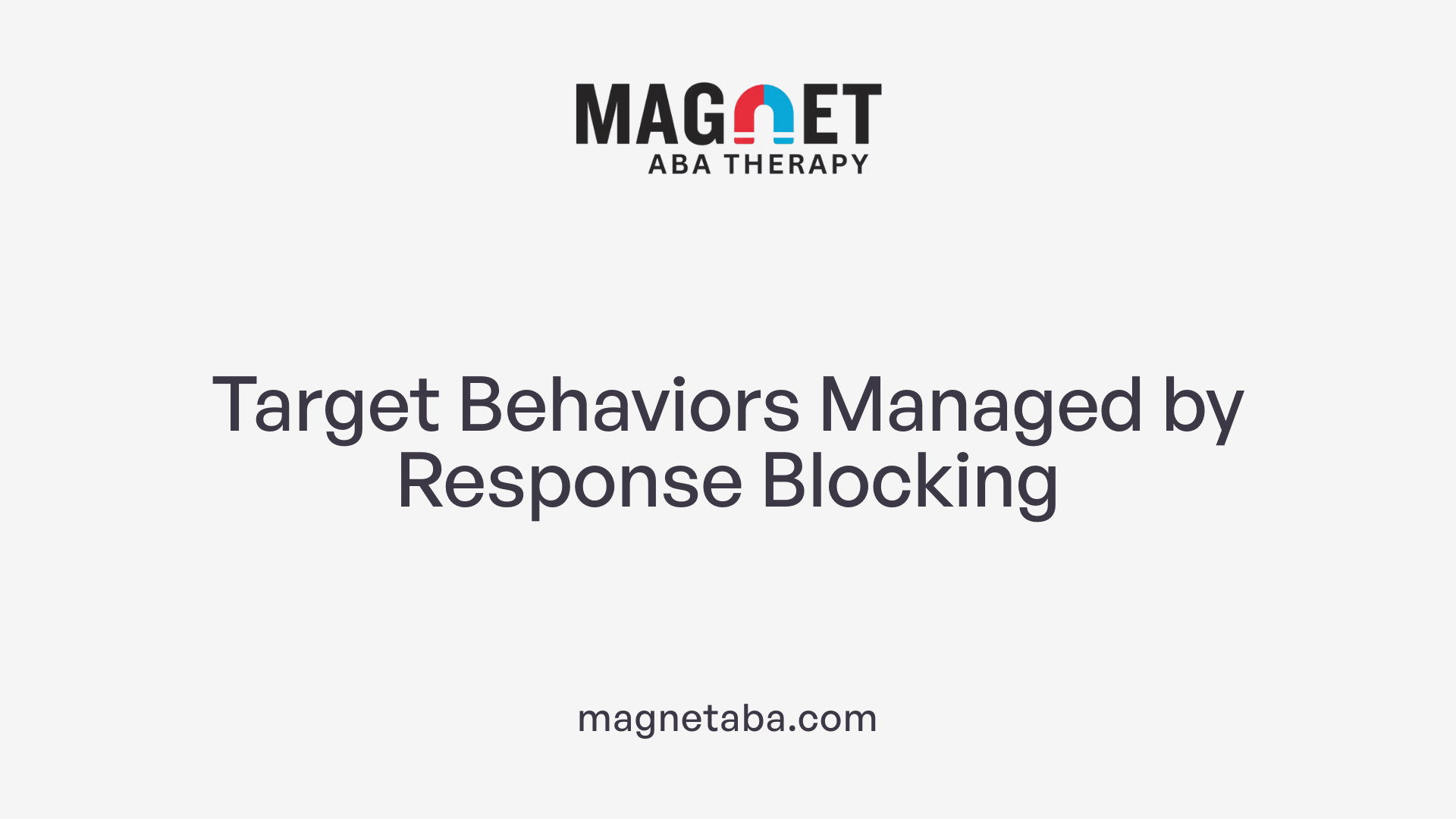
Examples of typical maladaptive behaviors targeted
Response blocking is often employed to manage a range of maladaptive behaviors that interfere with learning and safety. Common targets include self-injury, pica (ingestion of non-food items), aggression, throwing objects, loud clapping, inappropriate touching, and mouthing of inedible surfaces.
Motorically based behaviors
This intervention is particularly suited for behaviors that are motorically based—that is, those involving physical actions or movements that can be directly interrupted or prevented. The physical nature of response blocking allows for effective management of such behaviors by physically intervening to stop them in real-time.
Criteria for clear behavioral definitions
For response blocking to be successful, the maladaptive behaviors must be clearly and operationally defined. This clarity ensures that the intervention is applied accurately and consistently, allowing caregivers or educators to identify the behaviors precisely and respond with the appropriate blocking technique immediately.
By focusing on well-defined, motorically expressed behaviors, response blocking provides a structured and practical means to reduce harmful or disruptive actions, particularly in younger students or individuals with developmental challenges.
Practical Application of Response Blocking Across Age Groups

How is physical guiding or blocking used with young children?
Response blocking is especially practical and effective for younger students. This often involves physically guiding or directly blocking their attempts to escape work tasks. For example, a teacher or caregiver may position themselves to prevent a child from leaving a task area prematurely, gently redirecting the child to stay engaged. This hands-on approach leverages the child's developmental stage, where physical prompts can be more easily integrated with other educational strategies.
What challenges exist when using response blocking with older or more aggressive students?
With older or more aggressive students, response blocking becomes more challenging. Physically preventing a behavior may not be as viable due to increased strength, risk of escalation, or the nature of the behavior itself. There is also a higher risk of injury or resistance, making direct physical intervention less practical and sometimes inappropriate in these cases.
Why is there a need for alternative strategies in certain cases?
Because of the limitations described, alternative strategies are necessary for older or more aggressive students. These may include using visual supports to clearly communicate that escape or breaks won't follow escape behaviors, differential reinforcement techniques to encourage appropriate alternatives, and other behavior modification methods that don't rely on physical intervention. These alternatives help maintain safety while still addressing maladaptive behaviors effectively.
Integrating response blocking with supportive techniques tailored to the individual's age and behavior type ensures more humane and effective interventions across diverse educational settings.
Integration of Response Blocking Within Educational and Daily Settings
Settings Where Response Blocking Is Implemented
Response blocking is commonly applied in educational environments where individuals engage in structured learning or daily routines. It is particularly useful in classrooms or therapeutic settings where maladaptive behaviors such as self-injury or escape attempts may disrupt learning or safety.
Combining With Self-Care and Recreational Activities
Beyond academic settings, response blocking is also integrated into daily self-care routines and recreational activities. For example, during self-care tasks like dressing or eating, staff may physically guide a student or block maladaptive behaviors to encourage participation. Similarly, during play or recreational activities, it helps ensure safe and appropriate engagement by preventing behaviors like throwing objects or inappropriate touching.
Role Within Comprehensive ABA Programming
Within Applied Behavior Analysis (ABA) programs, response blocking serves as a practical tool to complement other behavior modification strategies. It is often used alongside reinforcement techniques, such as Differential Reinforcement of Other behavior (DRO), to not only prevent maladaptive actions but also encourage alternative, positive behaviors. This integration fosters a more holistic approach to behavior management, targeting both prevention and skill development.
Overall, response blocking’s adaptability makes it a valuable component in diverse settings, supporting both learning and daily living while promoting safer, more constructive behavior patterns.
Step-by-Step Response Blocking Procedure
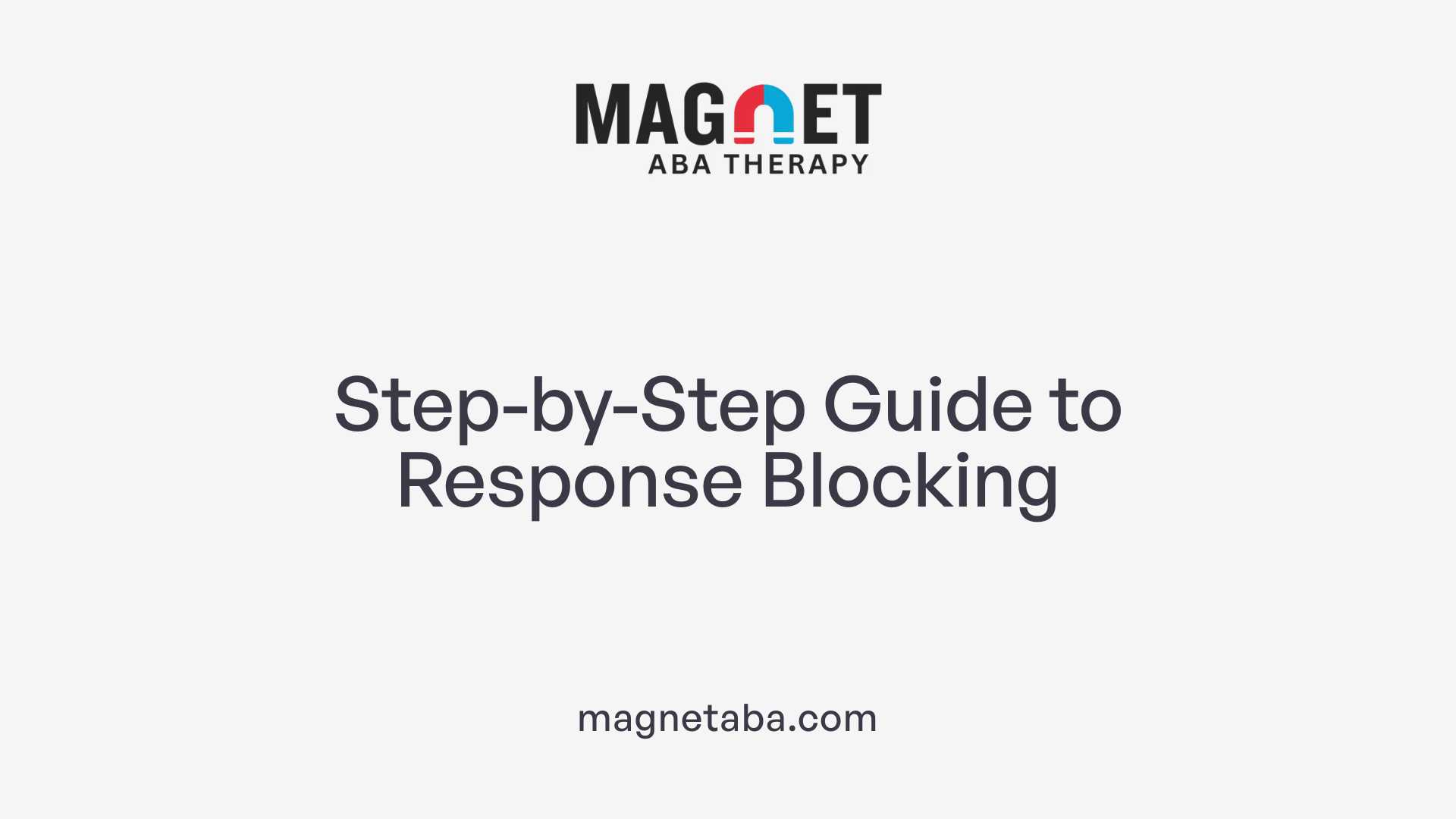
Behavior operational definition
The first step in response blocking is precisely defining the maladaptive behavior to target. This means clearly describing the specific actions such as thumb-sucking, self-injury, or aggression so that all caregivers and educators understand exactly what to look for. A well-defined behavior ensures accurate observation and consistent intervention.
Baseline behavior recording
Before starting intervention, it is essential to establish a baseline by recording the frequency, severity, and any triggers linked to the behavior. This assessment involves observing the individual over time to document how often and under what circumstances the behavior occurs. Such data provide a reference point to measure progress during response blocking treatment.
Immediate intervention at behavior onset
When the target behavior begins, the trained person—often a teacher or caregiver—immediately intervenes by physically blocking the behavior. This typically involves moving close to the individual and using gentle physical guidance or blocking techniques to prevent the behavior. For example, in the case of thumb-sucking, physical response blocking might involve using a thumb guard or covering the thumb to physically stop the sucking motion. Alongside physical blocking, verbal feedback is provided to help the individual recognize that the behavior will not be reinforced by escape or break.
This immediate, consistent intervention helps make the maladaptive behavior ineffective as a means of escape or sensory reinforcement. Over time, response blocking encourages the person to learn alternative, more appropriate behaviors by reducing the reinforcement that previously maintained the undesired action.
Integration with visual supports can further clarify to the individual that escape or breaks will not follow the behavior. This combined approach enhances the effectiveness of response blocking, especially when targeted behaviors are motorically based and clearly defined.
The procedure is practical, especially for younger students or individuals with behaviors maintained by automatic reinforcement, such as the documented case of a child with autism where response blocking paired with differential reinforcement led to a significant reduction in thumb-sucking behaviors.
Role of Visual Supports in Enhancing Response Blocking
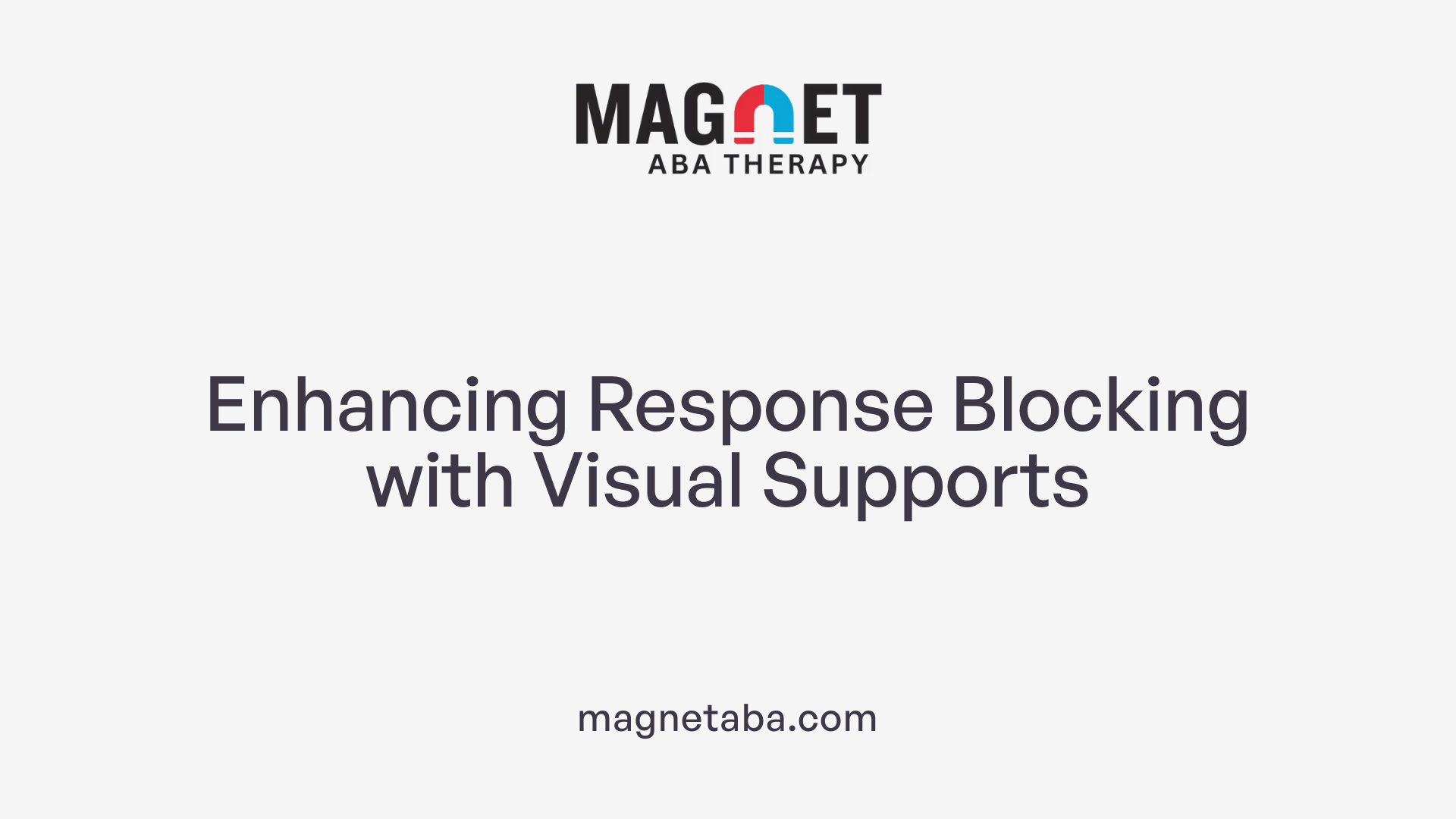
Visual tools to communicate behavioral expectations
Visual supports are effective aids used to clearly communicate behavioral expectations to students undergoing response blocking interventions. These aids, such as pictorial schedules or cue cards, visually outline what behaviors are appropriate and what will happen if escape attempts occur, thus helping students anticipate and understand the non-reinforcement of escape behaviors.
Preventing reinforcement of escape behavior
Incorporating visual supports alongside response blocking is crucial in preventing the inadvertent reinforcement of escape behaviors. By explicitly showing that escape or breaks will not follow maladaptive attempts to avoid tasks, visual tools reduce confusion and help extinguish escape-maintained behaviors. This strategy complements the physical aspect of response blocking by reinforcing the intervention’s goal through clear communication.
Supporting behavior clarity for learners
For many learners, especially those with developmental disabilities, visual supports provide clarity and consistency in expectations. They help bridge communication gaps and reduce anxiety about routine or task demands. When paired with response blocking, visual supports reinforce the message that maladaptive escape behaviors are ineffective, supporting learning of more appropriate behaviors and reducing confusion around consequences.
In summary, visual supports enhance response blocking interventions by explicitly clarifying behavioral expectations, preventing reinforcement of escape behaviors, and supporting learners’ understanding through clear and consistent communication. This integrated approach promotes more effective behavior modification outcomes.
Importance of Avoiding Breaks or Timeout After Escape Attempts

Why Giving Breaks Can Reinforce Escape
Allowing breaks or timeouts immediately after a student attempts to escape can inadvertently reinforce the escape behavior. When a student learns that escaping a task results in a desirable break, their attempts to escape increase. This cycle strengthens the maladaptive behavior, making it more difficult to reduce over time.
Maintaining Consistency During Interventions
Consistency is critical when using behavior interventions like response blocking. Avoiding breaks following escape attempts ensures the intervention disrupts the escape-reinforcement cycle. Caregivers and teachers must consistently withhold access to breaks or timeouts immediately after such behaviors for the intervention to be effective.
Supporting Extinction of Escape Behaviors
By consistently denying escapes, the behavior loses its reinforcing power, supporting extinction—the process where the behavior decreases and eventually stops. The use of response blocking coupled with withholding breaks establishes clear boundaries, signaling to the student that escape behaviors will no longer lead to escape or relief. Visual supports can further clarify these expectations.
In summary, avoiding reinforcement through breaks or timeouts immediately after escape attempts is essential to promote learning of alternative, appropriate responses and successful behavioral intervention outcomes.
Combining Differential Reinforcement with Response Blocking: Evidence from Research
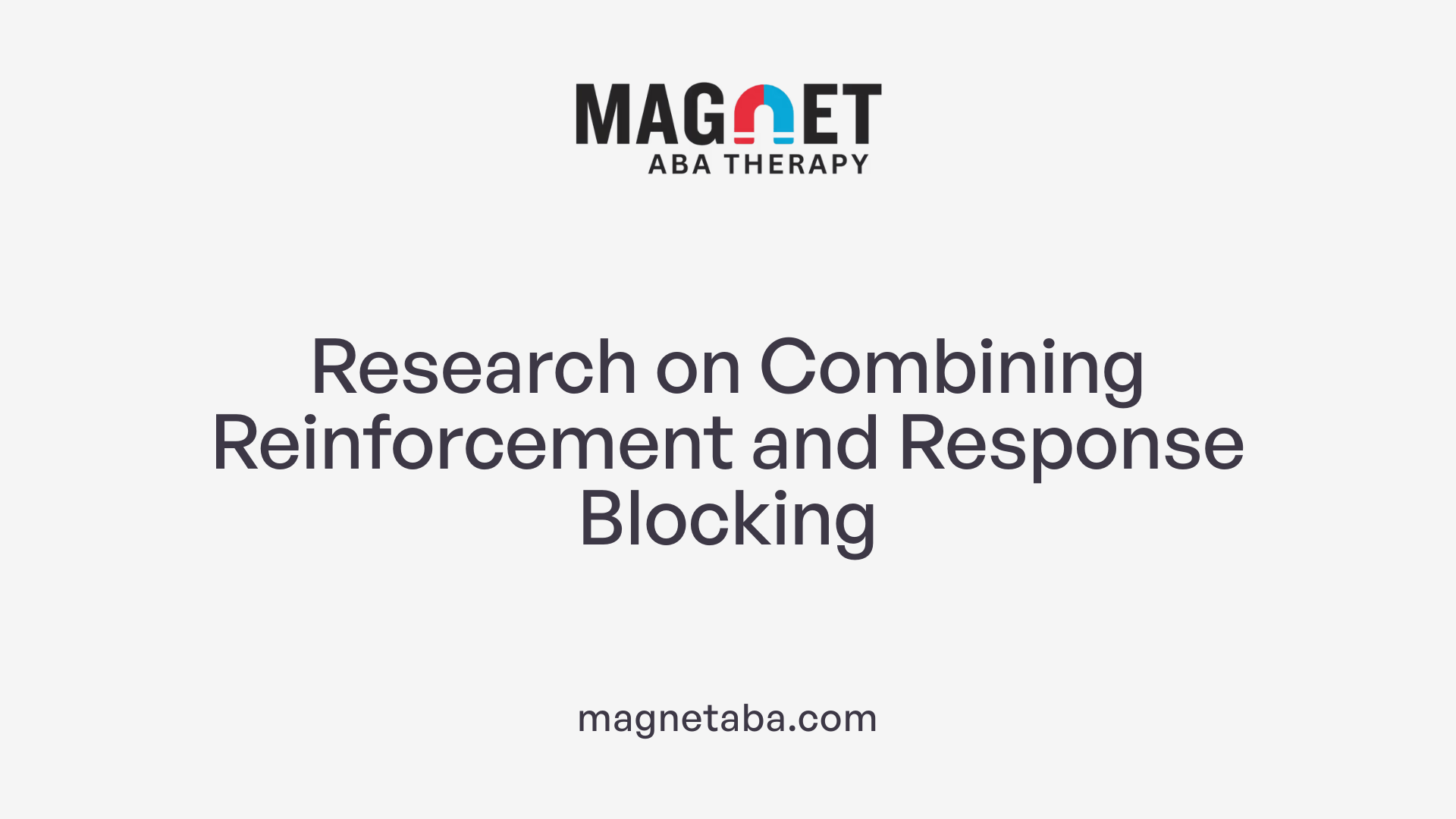
Case Study on Thumb-Sucking Behavior in Autism
A peer-reviewed case study published in the Journal of Medical Case Reports and Case Series examined the use of response blocking combined with differential reinforcement of other behavior (DRO) to address thumb-sucking in a child with autism. This maladaptive behavior, often maintained by automatic reinforcement, served as the study's primary focus, highlighting important strategies used in Applied Behavior Analysis (ABA).
Functional Behavior Assessment Findings
Before beginning the intervention, a thorough functional behavior assessment (FBA) was conducted. The assessment identified that the thumb-sucking behavior was automatically reinforced, meaning the behavior itself provided sensory feedback that maintained it. This insight guided the development of the intervention, emphasizing the importance of interrupting the behavior while encouraging alternative responses.
Use of Sensory Attenuation Devices (Thumb Guards)
The response blocking intervention utilized sensory attenuation devices, specifically thumb guards, to physically prevent the behavior from occurring. When combined with DRO—which provided reinforcement for other, appropriate behaviors—the intervention resulted in a remarkable decrease in thumb-sucking frequency. The average behaviors dropped dramatically from 46.4 during baseline to fewer than one during the intervention phases.
The study supports that physical prevention through response blocking, when paired with differential reinforcement, effectively reduces automatically maintained behaviors. It also adds to the existing body of research by evaluating how fading these sensory devices can maintain treatment effects. Importantly, parents found this combined approach highly acceptable, underlining its practical usefulness in real-world ABA therapy programs.
Outcomes of Response Blocking Interventions in Clinical Studies
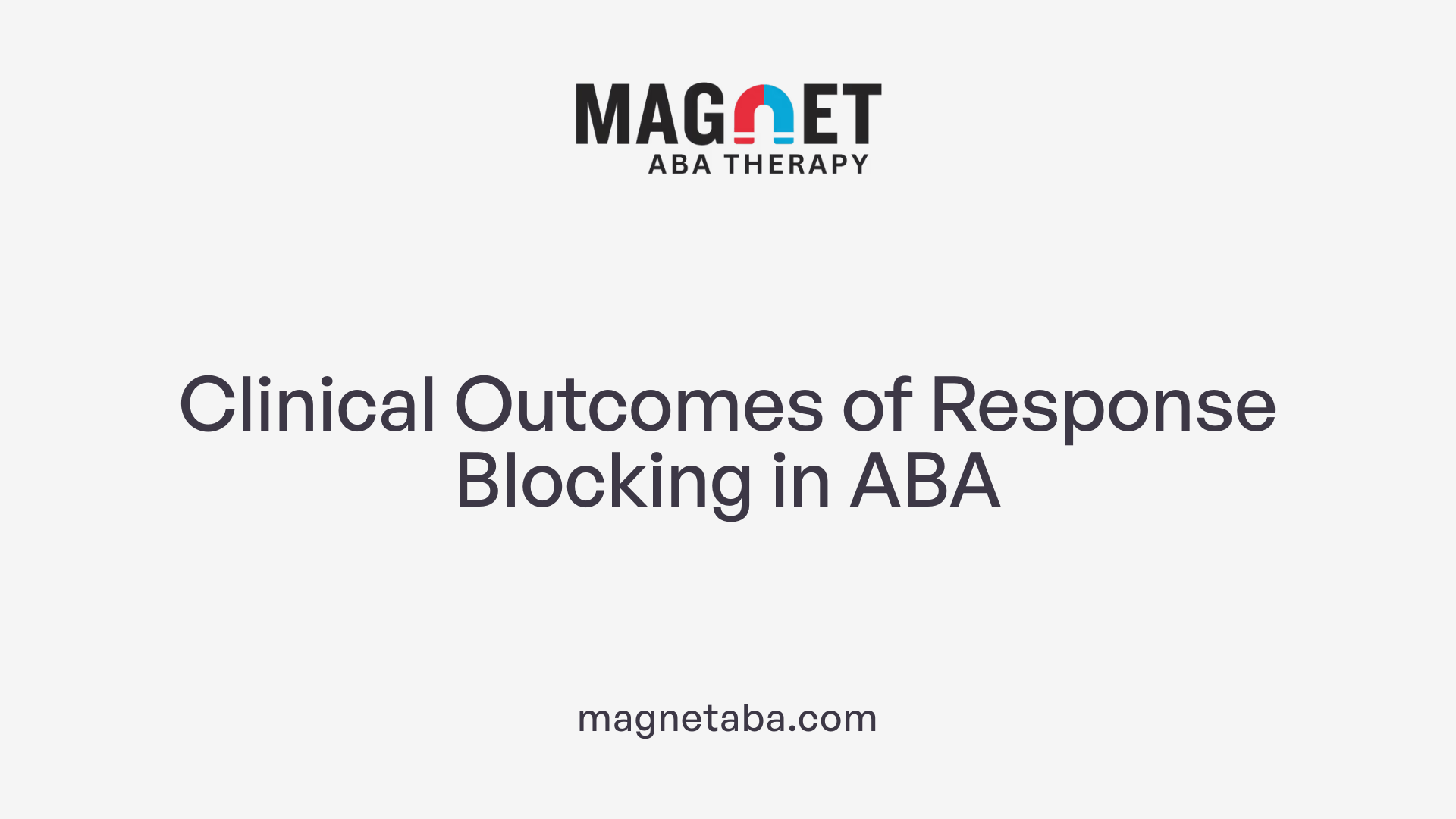
Significant behavior reduction results
Clinical research highlights response blocking's efficacy in markedly reducing maladaptive behaviors. In a published case study focusing on a child with autism, the intervention specifically targeted thumb-sucking behavior, which was maintained by automatic reinforcement as determined by a functional behavior assessment (FBA). The combined strategy of differential reinforcement of other behavior (DRO) and response blocking, utilizing thumb guards, demonstrated a dramatic decrease—from an average of 46.4 thumb-sucking incidents during baseline to fewer than 1 behavior per observation during intervention phases.
Empirical support and research extension
This study stands out by contributing empirical evidence endorsing the use of sensory attenuation devices, such as thumb guards, alongside response blocking. Beyond merely preventing the behavior physically, the intervention aligns with core behavior analysis principles by providing immediate feedback and fostering alternative behaviors. Furthermore, the research advances existing literature through its systematic evaluation of fading these sensory devices, offering valuable guidance for the gradual reduction of physical supports while maintaining treatment effectiveness.
Acceptance by caregivers and clinical relevance
The interventions' practical application is underscored by its high acceptability among parents, emphasizing both effectiveness and user-friendliness within real-world settings. This positive reception indicates that such response blocking techniques, particularly when combined with reinforcement strategies, are feasible and welcomed in Applied Behavior Analysis (ABA) practice. The documented success further points to a promising clinical relevance, especially for interventions tailored to automatically maintained behaviors in children with developmental disabilities.
The Role of Feedback During Response Blocking Interventions
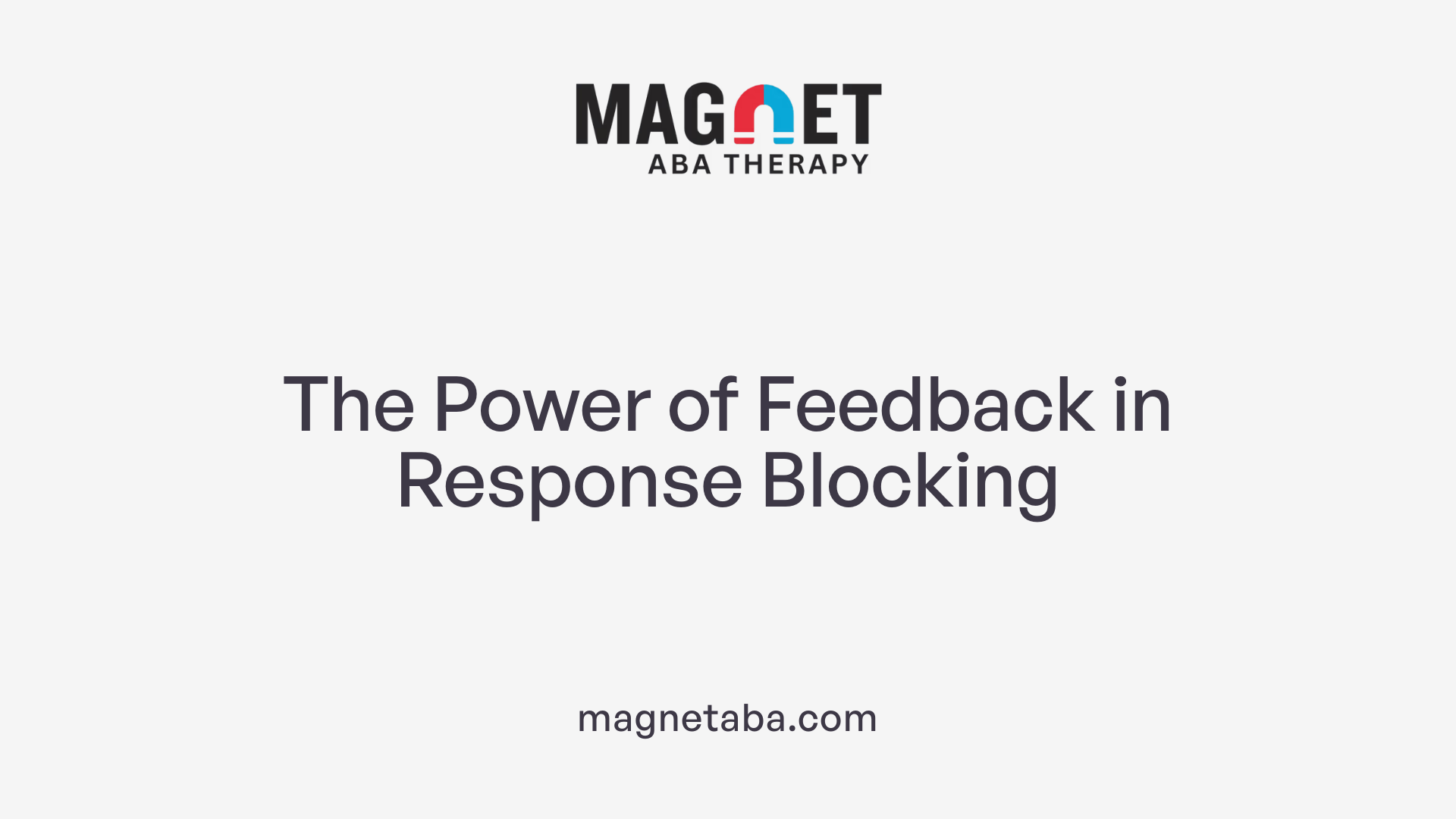
Verbal Feedback to Guide Behavior
During response blocking interventions, verbal feedback serves as an essential communication tool between the caregiver or teacher and the learner. When the person performing the blocking intervenes immediately to prevent a maladaptive behavior, such as thumb-sucking or escape attempts, they also provide clear, concise verbal cues. This feedback helps the individual understand that the undesired behavior is being blocked and that it will not lead to reinforcement, such as escape or sensory stimulation.
Teaching Alternative Appropriate Responses
Response blocking alone prevents the behavior but does not teach the learner what to do instead. Verbal feedback can guide individuals toward more appropriate or functional behaviors. For example, when blocking a maladaptive response like thumb-sucking, the caregiver may praise the individual when they engage in a desired replacement behavior. This combination encourages the learner to adopt behaviors that are socially acceptable and effective in gaining positive reinforcement.
Enhancing Learning and Behavioral Change
Feedback during response blocking increases the intervention’s effectiveness by reinforcing the link between behavior and consequences. By providing immediate verbal cues, the individual learns that undesirable behaviors will be blocked and will not result in reinforcement, while appropriate behaviors can be rewarded. This process supports behavioral change by promoting understanding and motivation. It is particularly beneficial in educational settings where integration with other teaching strategies is possible.
Together, physical interruption and verbal feedback form a comprehensive approach, fostering adaptive behavior modification and enhancing the long-term success of behavior interventions like those used in ABA therapy.
Ethical and Practical Considerations in Using Response Blocking
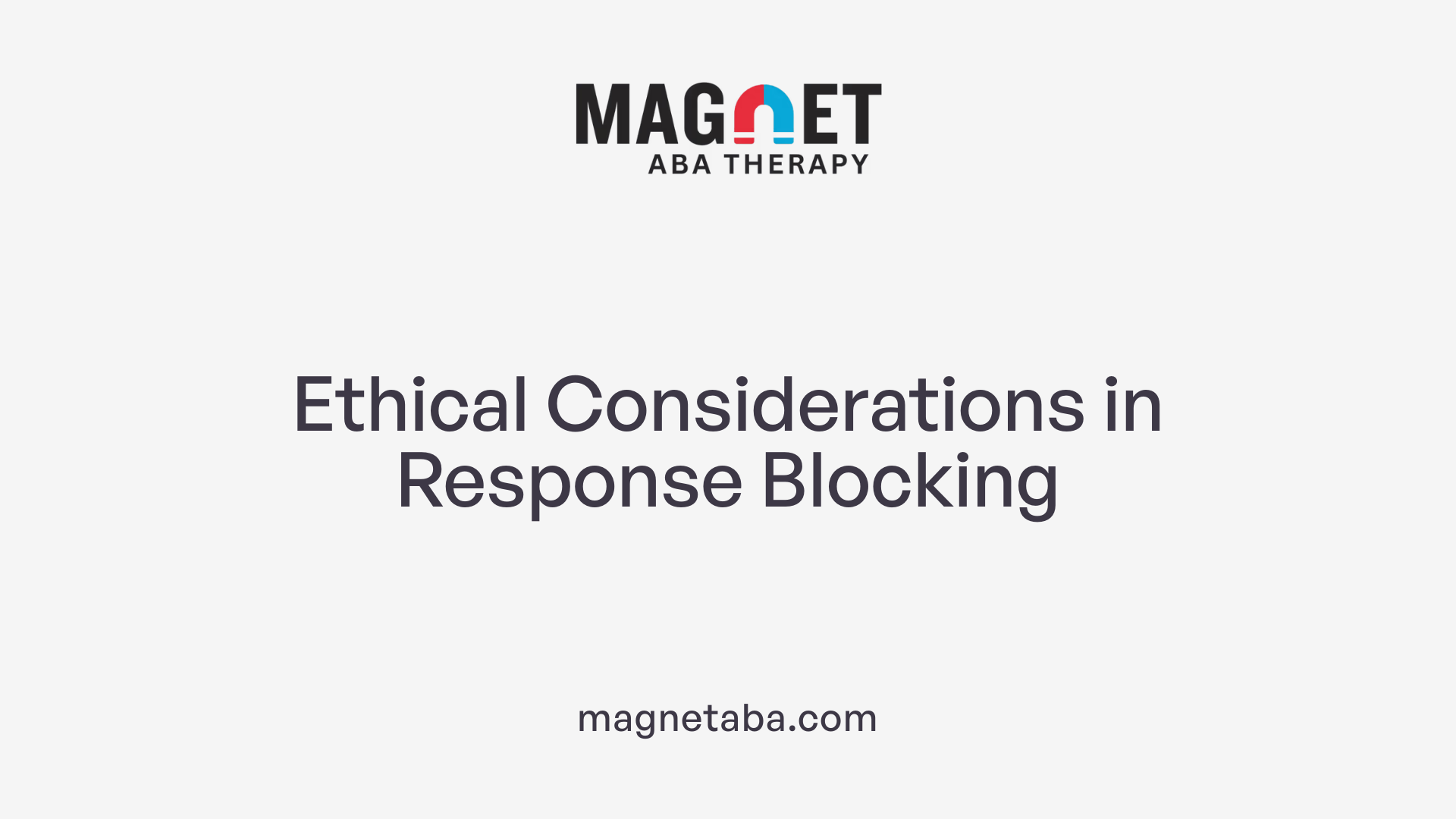
Training and qualifications of interventionists
Response blocking is a physical intervention that requires precise implementation to ensure safety and effectiveness. Individuals performing response blocking, often teachers or caregivers, must receive specialized training. This includes learning to accurately observe and record maladaptive behaviors and mastering the physical techniques needed to block behaviors safely. Proper training helps prevent inadvertent harm and maximizes the intervention's success.
Physical intervention protocols
Physical intervention protocols are critical in guiding how and when response blocking should be applied. The procedure involves closely monitoring the individual and intervening immediately when the undesired behavior begins. Physical contact is typically used to prevent the behavior, often by positioning oneself to block motor movements effectively. It is crucial that these interventions are carried out with minimal force, respect for the individual's dignity, and adherence to ethical standards, ensuring safety for both the client and the interventionist.
Balancing effectiveness and respect for client
While response blocking can effectively reduce maladaptive behaviors, especially in younger clients, ethical considerations must guide its application. For older or more aggressive individuals, response blocking may be less viable and could cause distress or escalate behaviors. Practitioners must balance the intervention's effectiveness with respect for the client's autonomy and comfort. Using visual supports to clarify expectations and avoid reinforcing escape behaviors with breaks or timeouts helps maintain dignity and promotes positive behavior learning.
Through comprehensive training, adherence to strict protocols, and a respectful approach, response blocking can be an effective part of behavioral intervention plans that prioritize client welfare and ethical treatment.
Summary and Significance of Response Blocking in ABA Therapy
Response blocking represents a critical, evidence-supported intervention within the broader framework of ABA therapy, particularly effective in preventing and reducing maladaptive behaviors in individuals with autism. While it involves direct physical intervention to interrupt undesired behaviors, proper implementation by qualified professionals, combined with complementary strategies like differential reinforcement and use of visual supports, enhances outcomes. Awareness of age-appropriate application, ethical practice, and individualized programming ensures response blocking remains a valuable tool within behavioral therapy aimed at promoting safer, more functional, and socially appropriate behaviors.
References
- Escape Behaviors {Response Blocking & Other Tips}
- Sage Reference - Response Blocking
- The Effects of a Differential Reinforcement of Other ...
- A Comprehensive Guide to ABA Therapist Requirements
- How to Become an Applied Behavior Analyst (ABA) Therapist
- Board Certified Behavior Analysts (BCBA)
- How to Become an ABA Therapist - School of Education
- Applied Behavior Analysis (ABA)
- The Controversy Around ABA
- The effectiveness of applied behavior analysis program ...












